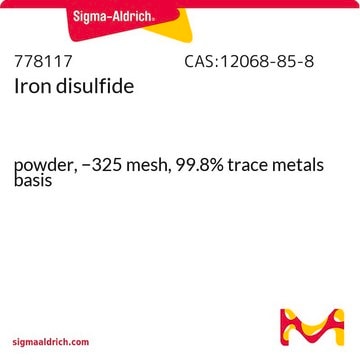510653
Copper(I) sulfide
anhydrous, powder, 99.99% trace metals basis
Synonym(s):
Chalcocite, Copper(1+) sulfide, Dicopper monosulfide
About This Item
Recommended Products
grade
anhydrous
Assay
99.99% trace metals basis
form
powder
technique(s)
NMR: suitable
impurities
≤150.0 ppm Trace Metal Analysis
density
5.6 g/mL at 25 °C (lit.)
application(s)
battery manufacturing
SMILES string
[Cu]S[Cu]
InChI
1S/2Cu.S
InChI key
JESPAFKOCOFQIN-UHFFFAOYSA-N
Looking for similar products? Visit Product Comparison Guide
Related Categories
General description
Packaging
accessory
Storage Class Code
11 - Combustible Solids
WGK
WGK 3
Flash Point(F)
Not applicable
Flash Point(C)
Not applicable
Personal Protective Equipment
Certificates of Analysis (COA)
Search for Certificates of Analysis (COA) by entering the products Lot/Batch Number. Lot and Batch Numbers can be found on a product’s label following the words ‘Lot’ or ‘Batch’.
Already Own This Product?
Find documentation for the products that you have recently purchased in the Document Library.
Customers Also Viewed
Our team of scientists has experience in all areas of research including Life Science, Material Science, Chemical Synthesis, Chromatography, Analytical and many others.
Contact Technical Service













